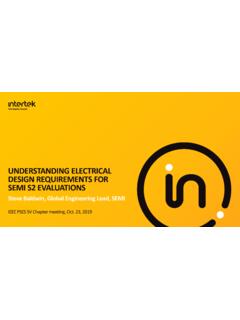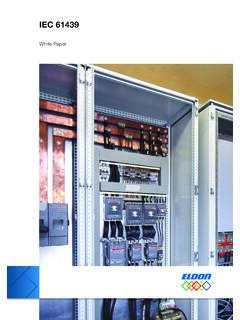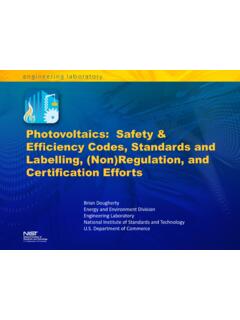Transcription of Guide To Electrical Safety Testing - Hipot
1 To ElectricalSafety TestingElectrical Safety Compliance Simplified GENERAL INFORMATIONWhy Test?2 There are four main reasons why you should Safety test your products prior to shipment1. SafetyEnsure that the product is not going to pose a hazard to the end QualityDetect workmanship defects and prevent faulty components from being Cost ControlIdentify production problems before a product is shipped, preventing costly LiabilityPrevent product liability suits because the responsibility of performing Electrical Safety tests ultimately rests on the manufacturerNRTL standards dictate that Electrical products incorporate two lines of defense to protect the user from Electrical shockInsulationSafety Grounds Separates power lines from low voltage circuits. Separates power lines from isolated power supplies. Isolates input power from the chassis or case of an Electrical device.
2 Allow dangerous fault currents to return to system ground. Enables circuit breakers to open. Safeguards against fire. Protects against damage to Electrical (Nationally Recognized Testing Laboratories) set standards outlining tests that must be performed on a product before it s considered safe for the consumer market. NRTLs implement and enforce Electrical Safety Testing to protect consumers from a potentially fatal electric shock. NRTL Examples: Underwriters Laboratories (UL - United States), TUV Rheinland (Germany), Canadian Standards Association (CSA - Canada), ETL ( intertek - United States) and CCC (China Compulsory Certification - China) Electrical products can be classified according to insulation typeClass I Products Terminate in 3 prong line cord (line, neutral and ground). Ground prong connects to product chassis.
3 Safety through basic insulation and proper II Products Double insulated products. Terminate in 2 prong line cord (line and neutral). Safety through dual layer of INFORMATION3 Effects of the Electrical current on the human bodyCurrentReaction** to 1 milliampPerception5 milliampsSlight shock felt, startled reaction6 to 30 milliampsPainful shock and inability to let go30 to 150 milliampsExtremely painful, respiratory arrest, ventricular fibrillation, death possible10 ampsCardiac arrest, severe burns** These effects are for voltages less than 600 volts. Many Electrical Safety testers can output voltages in excess of 5000 volts which can cause more severe reactions at lower current levels. As a manufacturer or test operator, it s up to you to ensure you have the proper knowledge and training to use high voltage equipment.
4 Before working with an Electrical Safety test station, you need to make sure you are a qualified operator according to OSHA standards generally specify two separate Testing categoriesType Test Performed as a laboratory or prototype test Done on sample basis Used to detect defects in product design More rigorous testingProduction Line Test Performed on 100% of products on the production line. Used to detect manufacturing or workmanship defects1 OSHA 29 CFR part Subpart S defines the training requirements for anyone exposed to voltages in excess of 50 Safety and Health AdministrationAn agency of the United States Department of Labor charged with ensuring safe working conditions as well as enforcing standards and providing workplace training and Subpart S Safety Compliance Simplified OPERATOR Safety AND TRAININGA Qualified Operator Must Know4 KnowledgeExample1.
5 Determine whether an exposed conductor is energized or tester with the output voltage ON. The HIGH VOLTAGE warning symbol illuminate RED when the tester is outputting. This indicates that the tester is in a dangerous state. 2. Determine the nominal voltage of an Electrical circuit by reading drawings, signs and labels. Know how to use the equipment. Every tester should come with a user s manual. Review this manual prior to using the power cord with label displayingthe nominal voltage and current of the device. 3. Understand approach distances and corresponding voltages to which you may be testers can output up to 5000 VAC. Always review product specifications before using the You should be trained to identify and understand the relationship between Electrical hazards and possible injury. Refer to the table Effects of Current on the Human Body on the preceding Know the Safety features of the equipment and utilize Slaughter testers have an automatic discharge circuit that will discharge the DUT in less than 200 msec after the test completes.
6 This ensures the DUT is safe for you to touch once the test has completed. 6. Determine if Personal Protective Equipment (PPE) is necessary, what type of PPE3 is necessary and how the PPE is rated. OSHA now requires in addition to being a Qualified Person, that you must wear PPE for protection from shock if you cross the Restricted Boundary. Note: The restricted boundary for live parts operating between 751 V and 15 kV is 2 feet2 image contains high voltage gloves, Safety glasses, a hard hat and high voltage are common examples of the PPEyou should wear as an operatorwhen using high voltage Safety AND TRAININGA Qualified Operator Must Know5 KnowledgeExample7. Know the methods of release for victims who are being shocked. Methods include using a non-conductivematerial ( a fiberglass pole) to release someone from a live circuit.
7 Using an E-Stop can also shut off power to the entire station and release the victim. DO NOT touch a person who is being shocked or you could also become part of the circuit!8. Understand that the tester is a variable voltage power source that will output current to any available ground path. Contacting the DUT during the test can result in a dangerous shock hazard. This image shows someone contactinga live circuit. The current flows directlythrough their body to ground causingsevere, possibly fatal injuries. 9. You must know the importance of discharging the all Slaughter testers do have an automatic discharging circuit, lifting the high voltage or return lead from the DUT before the test is complete can leave the DUT charged. If the Hipot does not have a complete circuit, it cannot discharge the DUT at the end of the Understand that each step in the work plan must be executed as NOT TAKE SHORT CUTS!
8 Refer to Test Station Safety Procedure Checklist to review your Hipot setup before you test. 2 NFPA 70E Table (C) outlines approach boundaries to live parts for shock protection. 3 NFPA 70E Section (C)(10) shall be used to determine the required PPE for the Safety Compliance Simplified OPERATOR Safety AND TRAININGS etting up a Safe Workstation6 One of the best ways to prevent injury is to ensure that the test station is set up safely and securely. Test stations can be setup with or without direct protection depending on your requirements. Direct protection means that the operator cannot physically come into contact with an energized DUT while a test is with protection against electric is wired to the Hipot tester s Remote Safety Interlock. This protects you from touching the DUT while a test is in progress. If the enclosure door is opened, the tester s high voltage is immediately an indication as to the status of the Testing area.
9 A green light indicates the tester is not outputting high voltage and the test area is safe. A red light indicates that the Hipot tester is active and to stay clear of the test area. Only use a work bench made of non-conductive material such as plastic or wood. This ensures no stray leakage current could flow through you during a test. DUT Safety EnclosureSignal Tower LightNon-ConductiveWork BenchAEHT ester used to test the Safety TesterBTest OperatorCHigh Voltage Insulation MatThis isolates you from ground which provides an additional means of protection when operating high voltage equipment. DEmergency Stop ButtonLocated on the perimeter of the test area. In the event of an emergency, someone outside the test area can hit the E-Stop button to immediately cut off power to the entire test SignsMark the Testing area with clearly posted signs that read: DANGER - HIGH VOLTAGE TEST AREA.
10 AUTHORIZED PERSONNEL O N Remote Palm SwitchesTwo hand operation switches force the operator to place a hand on each switch and hold them throughout the test. The palm switches should be placed at least " (550mm) apart to prevent the operator from one hand activation of both that any unqualified workers shall not come within 10' of an EXPOSED energized (National Electric Code) & NFPA (National Fire Protection AgencyJ10'10' Safety AND TRAINING710 10 DANGERHIGH VOLTAGEAUTHORISEDPERSONNEL ONLYE-STOPE-STOPAEEGGHCFFDB4 High Voltage signs compliant to ANSI Z535-20115 See NFPA 70E Table (C)ReferenceDescriptionADUT This large DUT prevents you from using a product Safety enclosure. Instead, other precautions must be taken to ensure a safe Testing Hipot Tester tester used to test the DUT. CTest Voltage Insulation Mat This isolates you from ground which provides an additional means of protection when operating high voltage equipment.)




